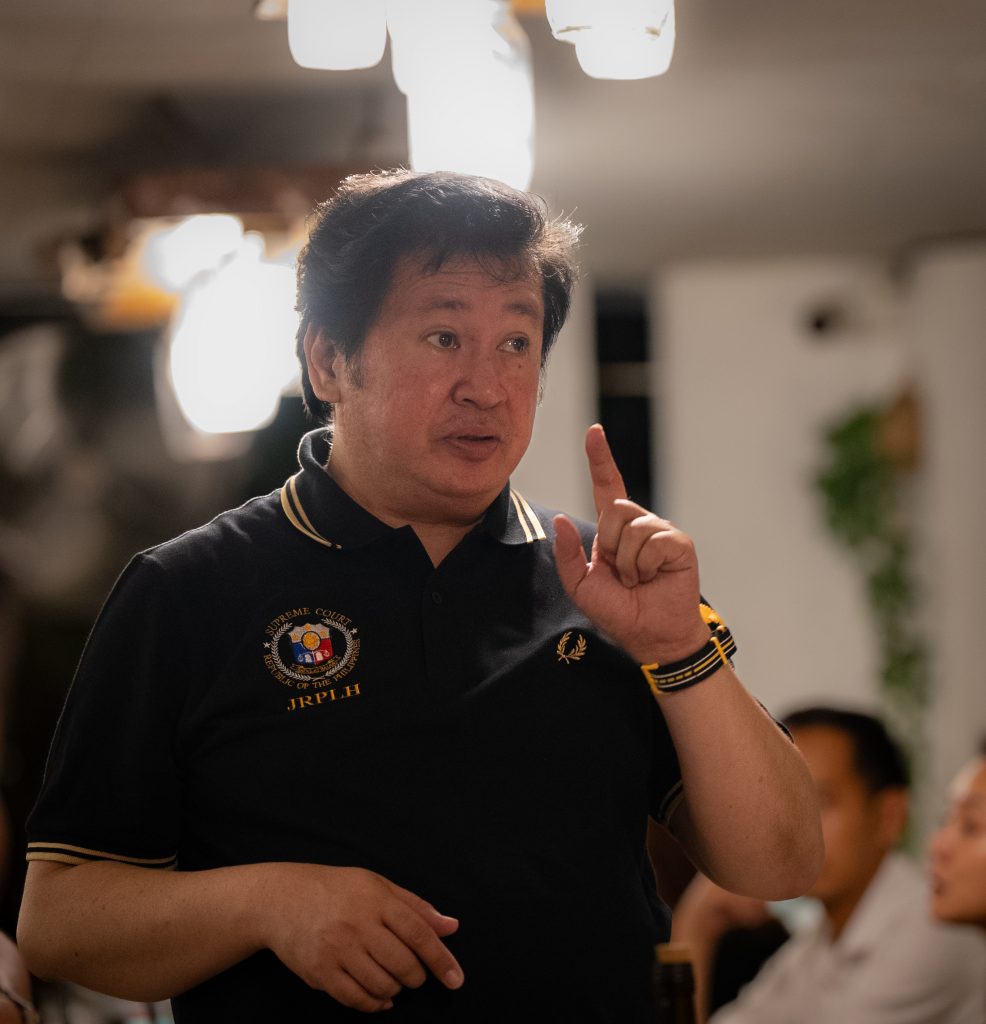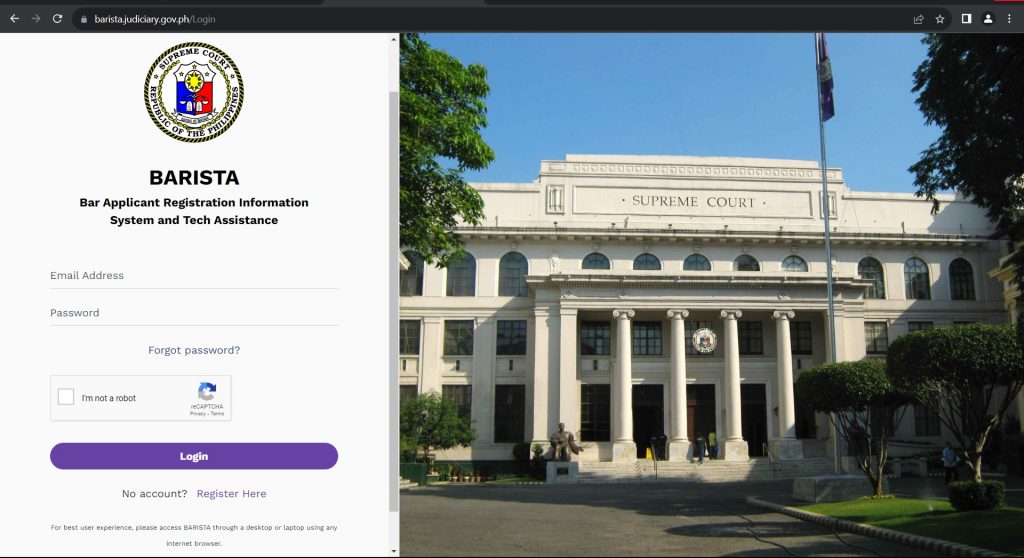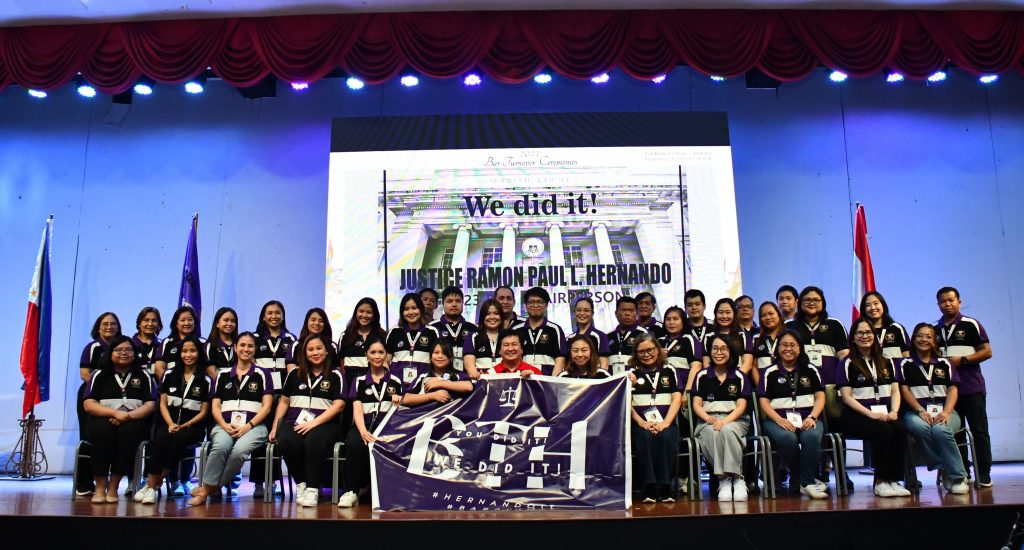The 2023 Bar Examinations: A Lasting Legacy of Associate Justice Ramon Paul L. Hernando
September 28, 2023

Supreme Court Associate Justice Ramon Paul L. Hernando, 2023 Bar Examinations Chairperson (Courtesy of the Supreme Court Public Information Office)
2023 will go down in history as the year when the Supreme Court released the results of two Bar Examinations—the 2022 Bar and the 2023 Bar—and administered the respective oath-taking and signing of the Roll of Attorneys ceremonies of the passers of the two examinations.
This historic feat will be made possible as part of the legacy of Bar reforms of Supreme Court Associate Justice Ramon Paul L. Hernando, Chairperson of the 2023 Bar Examinations.
A timeframe that shortens the period within which students graduate from law school, take the Bar, and eventually be admitted to the Bar; a user-friendly platform used by applicants before, during, and after the Bar Examinations; a relatable, all-out support system for the Bar examinees through the issuance of a series of detailed information materials; and additional incentives to all those who helped in the conduct of the Bar Examinations all form part of the would-be legacy of Justice Hernando as 2023 Bar Chairperson.
Condensed Bar Schedule
The opportunity for deserving Bar applicants who graduated law school and who successfully took the 2023 Bar Examinations to become full-fledged lawyers and start their legal practice in the same year they graduated law school. That, in a nutshell, is the primary objective of the Condensed Bar Schedule.
A brainchild of Justice Hernando, the Condensed Bar Schedule was developed to reduce the financial troubles tackled by Bar candidates in terms of lodging fees and other living expenses incurred during months of Bar review. It was also intended to ease the mental strain on the Bar candidates, who were able to finish the Bar Examinations in a span of eight days instead of an entire month.
The compressed timetable also sought to reduce the Court’s administrative costs and to minimize the disruption in the normal schedules of the schools which served as local testing centers (LTCs), of the local government units concerned, and of the courts whose personnel were deployed nationwide for conduct of the 2023 Bar Examinations.
The shortened timeframe was also crafted to shift the mindset of law students and encourage them to fully equip themselves for the Bar examinations prior to graduation; provide them an opportunity for earlier employment and to earn for their families; and accelerate their professional growth and contributions to society.
In its Resolution dated July 19, 2022 in Bar Matter No. 3978, the Court En Banc, upon the recommendation of Justice Hernando, approved the advancing of the Bar month from November 2023 to September 2023; the six-core-subject Bar Examination; the three examination dates; and the four examiners per subject to ensure the quick checking of the examinations.
The six core subjects are: Political and Public International Law (15%); Commercial and Taxation Laws (20%); Civil Law (20%); Labor Law and Social Legislation (10%); Criminal Law (10%); and Remedial Law, Legal and Judicial Ethics with Practical Exercises (25%).
In A.M. No. 19-03-24-SC, the Court also approved the Clinical Legal Education Program Guidelines for the 2023 Examinations, incorporating the suggestions made by Justice Hernando.

Bar Applicant Registration Information System and Tech Assistance or BARISTA is the first Bar-related online application platform fully developed by the Court, through the Office of the 2023 Bar Chairperson, Management and Information Systems Office, and Office of the Bar Confidant. (Courtesy of the Supreme Court Public Information Office)
The Bar Applicant Registration Information System and Tech Assistance, or BARISTA (https://barista.judiciary.gov.ph/), is the first Bar-related online platform fully developed by the Court, through the Office of the 2023 Bar Chairperson, Management and Information Systems Office, and Office of the Bar Confidant.
BARISTA, built on the foundations laid down by Justice Hernando’s eminent predecessors who also utilized an online platform for receiving of Bar applications, was designed to be user-friendly to Bar examinees and Court personnel alike, and to make the application process as seamless as possible.
“I have always emphasized that our Bar Team Hernando has built on the strong and solid foundations laid by Senior Associate Justice Marvic Leonen and Associate Justice Alfredo Benjamin Caguioa. From their BarPLUS, we developed BARISTA. While we have always looked back to and acknowledged the initial workings and success of BarPLUS, we had to necessarily adjust, streamline, and organize the new online platform for Bar applications in accordance with the peculiar exigencies of the 2023 Bar Examinations,” Justice Hernando said during the Turnover Ceremonies on September 24, 2023, the last day of the Bar Examinations.
Designed with the Bar examinees’ utmost convenience in mind, BARISTA features functionalities such as User Registration, Online Application Process and Payment, Document Upload, Venue Selection of Testing Centers, and automated generation of the examinees’ seat plans and Notice of Admission.
BARISTA has also made the processing of documents faster on the part of the Office of the Bar Confidant (OBC), which has bolstered the efficiency and feasibility of the 2023 Bar Examinations’ accelerated timelines.
Justice Hernando said that Bar Team Hernando intends to utilize BARISTA and its automated processes to organize certain logistics and documentation for the oath-taking and roll-signing ceremonies, which have traditionally been organized manually by the OBC.
Relatable, All-Out Support for Examinees

Justice Hernando gave his word early on that there would be adequate, proper, and wide dissemination of relevant information regarding the 2023 Bar Examinations.
He and the rest of Bar Team Hernando sought to do so not only through easy-to-understand and comprehensive Bar Bulletins, but through the use of infographics, video tutorials on BARISTA, the issuance and monthly updating of Frequently-Asked Questions received from examinees, the Examplify Manual, the utilization of the Court’s official social media channels, and the creation of an official Viber Group for examinees.
Likewise, Justice Hernando made sure to build a strong support system for all examinees and stakeholders since the start of his term as Bar Chairperson. He had been vocal about Bar Team Hernando’s monitoring of the applicants’ feedback to the Court’s Bar-related issuances, to ensure that the Court will be responsive and receptive to all suggestions and concerns of its stakeholders that could further streamline and improve all Bar-related preparations.
“It was pivotal that our entire operations were grounded on an effective, accurate, and relatable information dissemination campaign. We used the wide reach of social media…We phrased our Bar Bulletins to be as comprehensive and as simple as we can, and supplanting them with my personal notes under the hopes of stirring the examinees’ drive,” said Justice Hernando. “We gave our utmost to ease the burden of the Bar examinees and motivate them to do their best, in the hopes that they realize that the Court is one with them in their Bar journey and supporting them in every step of the way.”
Justice Hernando also stressed that the members of Bar Team Hernando took it upon themselves to create and disseminate detailed infographics for the easier consumption and understanding of the Bar takers, who were already saddled with numerous readings.
“Maybe we spoiled the 2023 baristas far too much. But I believe it contributed positively to their mental health and overall well-being during the Bar period, and hopefully, to their eventual success,” he stressed.
Incentives and Benefits to Bar Personnel and Volunteers
Leaving no stone unturned, Justice Hernando pushed for the reasonable adjustment of allowances for Bar personnel and the volunteers who would allot their time and energy to ensure the success of the 2023 Bar Examinations on top of their normal duties to the Court.
Under his term as Bar Chair, video-on-demand trainings were created through MS Teams to take into account the schedules of all Bar personnel, especially those of court personnel who volunteered to serve.
“Our Team values and appreciates all the help we receive from all over the Judiciary. As much as our funds would accommodate, we reasonably adjusted the allowances of the Bar personnel and of the hardworking volunteers who have allotted their time and energy to ensure the success of the 2023 Bar Examinations,” Justice Hernando said. “To all of the Bar personnel who have given their utmost to support the Court and our Bar examinees in this year’s examinations, from the bottom of my heart, I thank you for your service.”
The 2023 Bar Examinations were held at 14 LTCs nationwide on September 17, 20, and 24.
All announcements regarding the 2023 Bar Examinations may be viewed on its microsite at the Supreme Court website: https://sc.judiciary.gov.ph/bar-2023/. (Courtesy of the Supreme Court Public Information Office)












